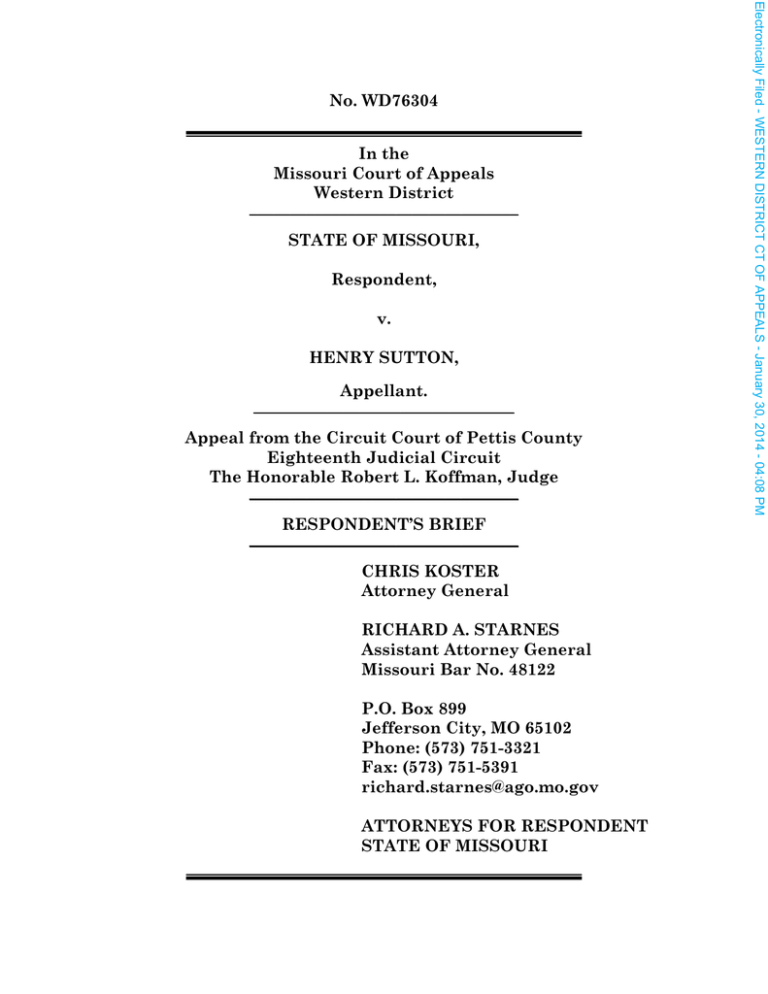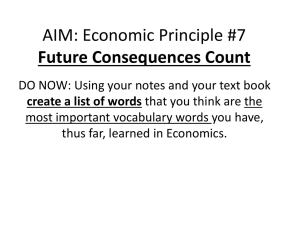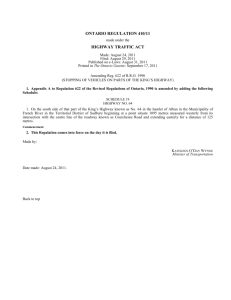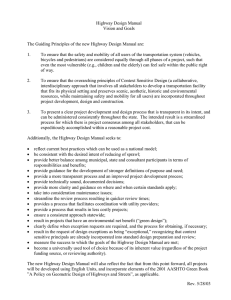No. WD76304 In the Missouri Court of Appeals
advertisement

In the Missouri Court of Appeals Western District _________________________________ STATE OF MISSOURI, Respondent, v. HENRY SUTTON, Appellant. ________________________________ Appeal from the Circuit Court of Pettis County Eighteenth Judicial Circuit The Honorable Robert L. Koffman, Judge _________________________________ RESPONDENT’S BRIEF _________________________________ CHRIS KOSTER Attorney General RICHARD A. STARNES Assistant Attorney General Missouri Bar No. 48122 P.O. Box 899 Jefferson City, MO 65102 Phone: (573) 751-3321 Fax: (573) 751-5391 richard.starnes@ago.mo.gov ATTORNEYS FOR RESPONDENT STATE OF MISSOURI Electronically Filed - WESTERN DISTRICT CT OF APPEALS - January 30, 2014 - 04:08 PM No. WD76304 TABLE OF AUTHORITIES .................................................................................2 STATEMENT OF FACTS ....................................................................................3 ARGUMENT .........................................................................................................6 CONCLUSION ................................................................................................... 14 CERTIFICATE OF COMPLIANCE AND SERVICE ...................................... 15 1 Electronically Filed - WESTERN DISTRICT CT OF APPEALS - January 30, 2014 - 04:08 PM INDEX Cases State v. Chaney, 967 S.W.2d 47, 52 (Mo. banc 1998) ................................ 6-7, 13 State v. Seeler, 316 S.W.3d 920 (Mo. banc 2010)......................................... 11-12 Brooks v. City of Sugar Creek, 340 S.W.3d 201 (Mo. App., W.D. 2011) .......... 11 Covert v. Fisher, 151 S.W.3d 70 (Mo. App., E.D. 2004) ......................................8 K.H. v. State, 403 S.W.3d 720 (Mo. App., W.D. 2013)...................................... 10 State v. Ison, 270 S.W.3d 444 (Mo. App., W.D. 2008) ...................................... 11 State v. Potter, 72 S.W.3d 307, 312 (Mo. App., S.D. 2002)............................... 13 Morris v. Blunt et al, 161 P. 1127 (Utah 1916) ............................................... 8-9 Other Authorities § 227.250, RSMo 2000 ..........................................................................................9 § 301.010, RSMo Cum. Supp. 2007 ................................................................... 10 § 302.010, RSMo Cum. Supp. 2009 ............................................................... 7, 10 § 302.010, RSMo Cum. Supp. 2012 ......................................................................7 § 302.321, RSMo Cum. Supp. 2005 ......................................................................7 2 Electronically Filed - WESTERN DISTRICT CT OF APPEALS - January 30, 2014 - 04:08 PM TABLE OF AUTHORITIES Appellant, Henry Sutton, was charged in the Circuit Court of Pettis County as a prior and persistent offender with the class D felony of driving while revoked (L.F. 11-12). This cause was tried by the court on January 24, 2013, the Honorable Robert L. Koffman presiding (L.F. 3). The sufficiency of the evidence is at issue in this appeal. Viewed in the light most favorable to the verdict, the following evidence was adduced: Shortly after 10:00 a.m. on July 16, 2011, Missouri State Highway Patrol Corporal Eric Keim was dispatched to the scene of a motor vehicle accident on Highway 65 on the southern edge of Sedalia (Tr. 13-14). When he arrived, he saw a small Jeep SUV parked in the center lane about 20 feet behind an Isuzu flatbed truck in the same lane (Tr. 14). Both vehicles were facing south (Tr. 14). The Jeep had front end damage; there was no visible damage to the truck (Tr. 14-15). Corporal Keim identified appellant as the driver of the flatbed truck (Tr. 15). Appellant told the corporal that he was working with a road construction crew that was painting turn arrows in the center lane (Tr. 16). He said that the lane was closed to traffic (Tr. 16). Appellant admitted that he was backing the truck up heading north when the Jeep pulled into the center lane (Tr. 16). The Jeep stopped so close to the truck that appellant 3 Electronically Filed - WESTERN DISTRICT CT OF APPEALS - January 30, 2014 - 04:08 PM STATEMENT OF FACTS the Jeep (Tr. 16). Corporal Keim saw that the work crew had two trucks on either end of the work site with signs with arrows directing traffic around the trucks (Tr. 17). There were no physical barricades blocking access to the center lane or orange cones marking off the area as a work zone (Tr. 18). There were warning signs designating the area as a work area, but nothing designating the center lane as “closed” (Tr. 19). The painting crew was continually moving as it worked (Tr. 18). The trucks were not Missouri Department of Transportation trucks and therefore not marked as such, but belonged to a private St. Louis company (Tr. 19). Appellant’s license was revoked at the time of the accident under a tenyear denial which was not eligible for reinstatement until 2018 (Tr. 17-18, 22). Appellant was cited for driving while revoked (Tr. 17-18). Appellant testified in his own defense, as well as calling the owner of the company who was doing the road work at the time of the accident, to support a defense that the portion of Highway 65 appellant was driving in was not a “public highway” at the time work was being done in it (Tr. 24-50). While the owner testified that the Department of Transportation has to approve any plan for installing traffic control markings prior to the work and 4 Electronically Filed - WESTERN DISTRICT CT OF APPEALS - January 30, 2014 - 04:08 PM could not see the Jeep in his rear view mirrors, and therefore he backed into not testify that the State had actually closed the center lane for the work being done (Tr. 31-32). Appellant admitted that he was operating the truck, that there was no other truck behind him, and that he knew his driving privilege was revoked at the time (Tr. 41-42, 46-47). But he claimed that the center lane was closed, that there was a sign stating that up at the scene, and that there were cones set behind the truck (Tr. 40-41, 50). Appellant was found guilty as charged (L.F. 15-16). The court imposed a $500 fine (L.F. 22-23). This appeal followed. 5 Electronically Filed - WESTERN DISTRICT CT OF APPEALS - January 30, 2014 - 04:08 PM therefore “has to sanction any kind of road closings to do road work,” he did The trial court did not err in denying appellant’s motion for judgment of acquittal at the close of all of the evidence because there was sufficient evidence that appellant was driving while revoked in that the evidence showed that appellant was operating a motor vehicle on a “highway” while his driving privilege was revoked. Appellant claims that there was insufficient evidence to support his conviction for driving while revoked, arguing that the evidence showed that he only drove in a closed road work zone portion of the highway, which he contends does not satisfy the statutory requirement that he drive on a “highway” (App. Br. 13-24). But both the law and facts showed that appellant was driving on a highway, and therefore there was sufficient evidence to support his conviction. In examining the sufficiency of the evidence, appellate review is limited to a determination of whether there is sufficient evidence from which a reasonable trier of fact might have found a defendant guilty beyond a reasonable doubt. State v. Chaney, 967 S.W.2d 47, 52 (Mo. banc 1998). The appellate court does not act as a “super juror” with veto powers, but gives great deference to the trier of fact. Id. In applying the standard, the appellate court accepts as true all of the evidence favorable to the state, 6 Electronically Filed - WESTERN DISTRICT CT OF APPEALS - January 30, 2014 - 04:08 PM ARGUMENT evidence and inferences to the contrary. Id. Appellant’s entire claim rests on his assertion that he was not guilty of driving while revoked because he was driving in a “closed construction zone,” which was not accessible to the public while closed and thus no longer a “highway” under the driving while revoked statute (App. Br. 13-25). But appellant’s claim is wrong under both the law (as a construction zone on a highway is still a “highway”) and the facts (appellant was not driving in a “closed construction zone” but on the publicly accessible highway). A person commits the crime of driving while revoked if that person operates a motor vehicle on a “highway” while his license or driving privilege has been cancelled, suspended, or revoked and acts with criminal negligence with respect to knowledge of the fact that his driving privilege has been cancelled, suspended, or revoked. § 302.321.1, RSMo Cum. Supp. 2005. A “highway” is “any public thoroughfare for vehicles, including state roads, county roads and public streets, avenues, boulevards, parkways, or alleys in any municipality[.]” § 302.010(6), RSMo Cum. Supp. 2009.1 The word “highway” 1The definition is § 302.010(7) of the current version of the statute. § 302.010(7), RSMo Cum. Supp. 2012. 7 Electronically Filed - WESTERN DISTRICT CT OF APPEALS - January 30, 2014 - 04:08 PM including all favorable inferences drawn from the evidence, and disregards all travel[.]” Covert v. Fisher, 151 S.W.3d 70, 77 (Mo. App., E.D. 2004). There is no question that the street appellant was driving on when he struck the other vehicle, Highway 65, is generally a “highway” under the statute (Tr. 14). But under appellant’s reasoning, the highway ceased to be a highway while the work crew appellant belonged to was working on the turn lane markings because it was not open to the public (App. Br. 24). Even assuming this section of the highway was a “closed construction zone,” there is no authority for appellant’s conclusion that a highway ceases to be a highway while the public is temporarily prevented from accessing a portion of it due to road construction. The two authorities appellant suggests support his interpretation of the statute—the Utah case of Morris v. Blunt et al, 161 P. 1127 (Utah 1916), and § 227.250, authorizing the State Highway Commission to temporarily close portions of a highway to public use, actually show that, even when closed, a highway is still a highway. Morris was an appeal of a suit to quiet title and addressed whether a portion of private land had become dedicated to use as a public highway. Morris, 161 P. at 1131. Whether the property in question became a “public highway” depended on whether it had been used as a “public thoroughfare.” Id. The Utah Supreme Court stated that property is a “public thoroughfare” 8 Electronically Filed - WESTERN DISTRICT CT OF APPEALS - January 30, 2014 - 04:08 PM has “consistently been interpreted to apply to any street used for public this case, the public had a general right of passage to the portion of Highway 65 at issue in this case; the portion was the left hand turn lane in the middle of the highway. While that general right of passage may have been limited in places at the specific time at issue due to road work, it did not change the character of the highway as one where the public had a general right of passage. Thus, under the definition of “highway” appellant relies on in Morris, appellant was driving on a highway. Likewise, the statute about road closings appellant relies on also supports a conclusion that a closed portion of a highway is still a highway. That statute, in relevant part, gives the State Highway Commission the “power to close temporarily for the purpose of construction or repair any portion of a state highway to public use.” § 227.250, RSMo 2000. The statute does not indicate that any closed portion of a highway ceases to be considered a highway. Instead, it continues to identify any closure as a “portion of a state highway” and suggests that the temporary nature of any closure does not change the existential nature of the highway. Thus, appellant’s reliance on this statute does not support his claim that the closed portion of a highway is not a highway. 9 Electronically Filed - WESTERN DISTRICT CT OF APPEALS - January 30, 2014 - 04:08 PM when “the public have a general right of passage.” Id. (emphasis added). In has concluded that a closed portion of a “highway” under chapter 301 (defined identically to the definition of “highway” in chapter 302) is still a highway despite its temporary closure. In State v. Seeler, 316 S.W.3d 920 (Mo. banc 2010), the Court was discussing the meaning of the “highway’s right-of-way” language in the involuntary manslaughter statute as it related to a closed highway construction zone. Id. at 924, 926. The court stated, “The closed construction zone still would be part of the highway as defined in section 301.010, but is it part of the right-of-way, an undefined term in this context?” Id. at 926. The definition of “highway” in § 301.010 is identical to the definition in § 302.010 at issue in this case. § 301.010(19), RSMo Cum. Supp. 2007; § 302.010(6), RSMo Cum. Supp. 2009. This Court presumes that all statutes relating to the same subject matter are read in pari materia and should be construed together, consistently, and harmoniously. K.H. v. State, 403 S.W.3d 720, 722 (Mo. App., W.D. 2013). Thus, as the Missouri Supreme Court has deemed the closed portion of a highway to still be a “highway” under a statute identical to § 302.010(6), that reasoning should apply here. Appellant argues that Seeler should not be deemed binding in this case because the Supreme Court’s reasoning was dicta. Statements are nonbinding dicta if they are not essential to the court’s decision of the issue 10 Electronically Filed - WESTERN DISTRICT CT OF APPEALS - January 30, 2014 - 04:08 PM Far more persuasive authority comes from our Supreme Court, which 2011). While the court’s interpretation of a “highway” under § 301.010 did not directly lead to the Court’s finding, it was still an essential part of the holding. The Court was examining an amendment to the charging document’s language alleging the leaving of the “highway’s right-of-way” to language alleging entering a highway construction zone “lane closed to traffic.” Seeler, 316 S.W.3d at 923. It found that removing the “highway’s right-of-way” language changed the alleged offense so much that it prejudiced the defense, which was based on the “right-of-way” language. Id. at 926-28. Thus, the Court’s discussion of what constitutes a highway was relevant to its discussion of what constituted a highway’s right-of-way. Therefore, the Court’s interpretation of § 301.010 was an essential part of the reasoning leading to the holding that the amendment prejudiced Seeler. As such, the Court’s interpretation of the definition of “highway” was not dicta. Further, even if the Court’s interpretation was dicta, “dicta can be persuasive when supported by logic.” State v. Ison, 270 S.W.3d 444, 446 (Mo. App., W.D. 2008). The Supreme Court’s interpretation is more logical than the alternative. The Court’s interpretation is simply that if something is generally a highway, it remains a highway even during temporary lack of public access during road work. Appellant’s argument, unsupported by any 11 Electronically Filed - WESTERN DISTRICT CT OF APPEALS - January 30, 2014 - 04:08 PM before it. Brooks v. City of Sugar Creek, 340 S.W.3d 201, 212 (Mo. App., W.D. if a portion is temporarily closed for road construction, even, as in this case, if the remainder of the highway is still an open highway. While appellant’s claims that “common sense would indicate” that a “highway” becomes “not a highway” for the portion of time the public is not temporarily using it, the opposite is true. One would not say a motor vehicle is not a motor vehicle because it is sitting in a garage instead of being driven. One would not say that a handgun is not a handgun when it is not being fired. In the same way, a highway generally open for public use still exists as a highway even when not being used as such at a given moment in time. Therefore, because the logic of the alleged dicta in Seeler is persuasive, this Court should conclude as the Supreme Court did in Seeler that even the temporarily closed portion of a highway is still a highway under § 302.010(6). Finally, even if appellant’s legal claim had any merit, appellant would still not be entitled to relief, as the evidence showed that appellant was not driving in a “closed construction zone” at the time of the accident. According to Corporal Keim, there were no signs indicating that any portion of the road (including the center lane) was closed to traffic2 (Tr. 19). There were no traffic 2 Appellant claimed in his testimony that there were signs stating “Center Lane Closed” (Tr. 41). The court was under no obligation to believe 12 Electronically Filed - WESTERN DISTRICT CT OF APPEALS - January 30, 2014 - 04:08 PM authority, persuasive or otherwise, is that a highway ceases to be a highway off the work zone and prevented anyone from entering the lane (Tr. 18). The work trucks, with arrows pointing traffic around them, were the only indicators of the boundaries of the work zone (Tr. 45). Because there were no barriers or other markers closing the lane to traffic other than the work trucks, at the time the other driver entered the center lane, it was not inside the only part of the area that could be considered the “work zone”—the area between the trucks. Thus, when appellant backed the truck into area already occupied by the other vehicle, appellant was not driving inside the closed area of highway, but moving the truck into an open area of the highway. Therefore, under the facts in the light most favorable to the verdict, appellant was not driving in a work zone, but on the open portion of the highway. As such, there was sufficient evidence to support appellant’s conviction for driving while revoked on a highway as defined by § 302.010. For the foregoing reasons, appellant’s sole point on appeal must fail. this self-serving testimony which conflicted with Corporal Keim’s testimony (Tr. 19). State v. Potter, 72 S.W.3d 307, 312 (Mo. App., S.D. 2002)(“The trial court is free to believe or disbelieve any testimony.”). This Court disregards all evidence and inferences contrary to the verdict. Chaney, 967 S.W.2d at 52. 13 Electronically Filed - WESTERN DISTRICT CT OF APPEALS - January 30, 2014 - 04:08 PM cones or other barriers, other than the work trucks themselves, that marked In view of the foregoing, appellant’s conviction and sentence should be affirmed. Respectfully submitted, CHRIS KOSTER Attorney General /s/ Richard Starnes RICHARD A. STARNES Assistant Attorney General Missouri Bar No. 48122 P. O. Box 899 Jefferson City, MO 65102 (573) 751-3321 Fax (573) 751-5391 Attorneys for Respondent 14 Electronically Filed - WESTERN DISTRICT CT OF APPEALS - January 30, 2014 - 04:08 PM CONCLUSION I hereby certify: 1. That the attached brief complies with the limitations contained in Supreme Court Rule 84.06 and WD Special Rule XLI, and contains 2,521 words as determined by Microsoft Word 2007 software; and 2. That a copy of this notification was sent through the eFiling system on this 30th day of January, 2013, to: Margaret Johnston Office of the State Public Defender Woodrail Center, Building 7, Suite 100 1000 West Nifong Columbia, Missouri 65203 CHRIS KOSTER Attorney General /s/ Richard A. Starnes RICHARD A. STARNES Assistant Attorney General Missouri Bar No. 48122 P.O. Box 899 Jefferson City, Missouri 65102 (573) 751-3321 Fax (573) 751-5391 richard.starnes@ago.mo.gov Attorneys for Respondent 15 Electronically Filed - WESTERN DISTRICT CT OF APPEALS - January 30, 2014 - 04:08 PM CERTIFICATE OF COMPLIANCE AND SERVICE


